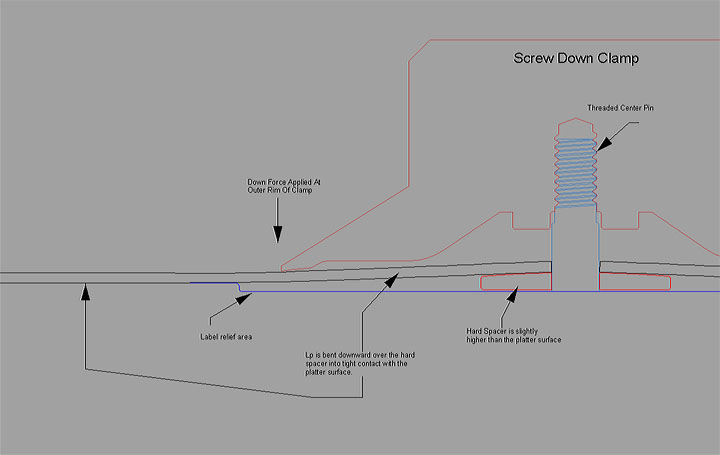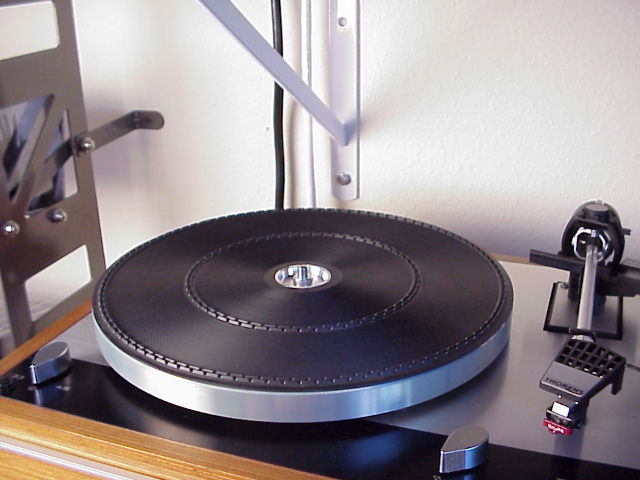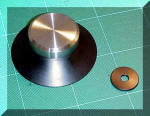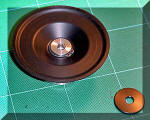-edible zone-
-- So, what's the purpose of a platter mat anyway...?
-
Should it merely be a cushy pad for the record to lie against while being played...? If so, why...? Explain that.
-
Should it serve to grip both the record and the platter surfaces in order to prevent record slippage...?
-
Should it serve to isolate the record from low frequency bearing-rumble coming up off the platter...?
-
Should it serve to damp resonance coming off the record as the record reacts to the stylus vibrating in the groove...?
-
Should the record be tightly coupled to the platter mat surface...?
-
Should the platter mat serve to de-couple the record from the platter, ...and even from the platter mat itself... as much as is possible...?
-
Should the platter mat react to resonant energy coming off the record and re-direct this energy into itself or allow the resonance to dissipate into air...?
-
Should the platter mat react to resonant energy coming off the record by re-directing this energy back into the record, into the stylus..?
-
Should it serve to conduct static electricity....? To not conduct static electricity...? To ground static electricity to the spindle...?
-
What if....you didn't use a platter mat?
Definitions:
Dampen: Websters
Dictionary def: To check or diminish vigor or activity.....
In the
audio world, the term dampen is used in combination with terms like
resonance and vibration. As in to dampen unwanted resonance.
Isolate: Websters Dictionary def: To keep by itself; separate from
others.....
In the audio world, the term isolate is used in
combination with terms like acoustic resonance, resonance and
vibrations. As in to isolate from unwanted acoustic resonance.
Decouple: Websters Dictionary def: To eliminate the interrelation
of, to separate
In the audio world this term means the same as its
definition. With regard to turntables, platters, mats and records it
means to separate one item from another physically.
Couple:
The opposite of Decouple. To mechanically couple can mean to press two
items together intimately. Such as using a record clamp to press the
record against the platter mat.
For this page I would like to examine different approach categories
commonly employed when designing the 'platter-to-record'
interface.
1) Record resonance's are absorbed into
the platter mat through a tightly coupled fit between mat and record.
The intent is to duplicate as closely as is possible the conditions
under which the original master disc was cut. Rigidity is the key
ingredient. Typically some type of clamping or weighting and curving
force from above the record is employed to assist in the coupling. Mat
construction is of a material designed to damp and dissipate resonant
energy. Or maybe the record is coupled to the bare platter surface. In
this case, the platter mass is intended to be enough to dampen resonant
energy off the record and from the bearing.
2) The
record lies upon a soft flat pad. The pad, known as a platter mat,
serves to cushion the record, provide grip and will offer some vibration
damping between record and the platter bearing. This type of mat may be
used with or without a record clamp.
3) Record is
decoupled as much as is possible from the record player by limiting
areas of contact between platter and mat and, with some, between mat and
record. This will include a volume of air under the record. Record
resonance's may be transmitted into this mat and dissipated or they may
by design be allowed to dissipate over time within the vinyl record
itself. The record is decoupled from the platter in this scheme.
* Category 1: Direct coupling between bare platter and the Lp.
*
Above: Section View of the Teres screw-down clamp system at work
(note: click thumbnail for full size image)
Above thumbnails, a Teres screw-down clamping system. With the hard delrin spacer located under the record, it raises the record slightly above the surface level of the bare platter. The outer face of the clamp, as it is screwed down on top of the record forces the record to curve downward in a gentle parabola until the soft vinyl record makes contact with the platter, the shape it conforms to. A typical result is a coupling between record and platter so efficient that a slight vacuum is noticed when removing the record from this player.
*Category 2:
* Cork
* DIY "None-Felt" mat --- Cheap and easy to make (with a cautionary note)
* Cork / leather mat
Category 3:
* The Thorens standard rubber mat. Yes, the original Thorens mat
decouples the record as do many others.
The Thorens standard rubber mat. Yes, the original Thorens mat
decouples the record as do many others.
* Ringmat Just pictures so far. More to come
* Spotmat turns into a project, then a product
* Tad Spotmat My interpretation of Malcom's Spotmat
* Cupboard liner platter mats. (if not for the residue issues, these have merit)
Commercially made platter mats:
* Boston Audio Design Mat 2 (a commercially made solid machined graphite platter mat)
* Vacuum Platter Mat (yes, Thorens made one for the TD126 circa 1983--- but I don't have one....sob...)
* Herbies Way Excellent Turntable Mat (yup, I bought one and it is good)
* What if I combined a cupboard liner mat and a Herbies Way Excellent mat into one thick mat and used that on the TD124? Well, I did and I like it.
* Teres solid acrylic platters with screw down clamp 'couples' the vinyl record snugly against the platter. How effective were these? Quite good I thought -- back when I had the Teres. Having tried several different platter mats on that turntable, I went with its original design as the optimal method.



